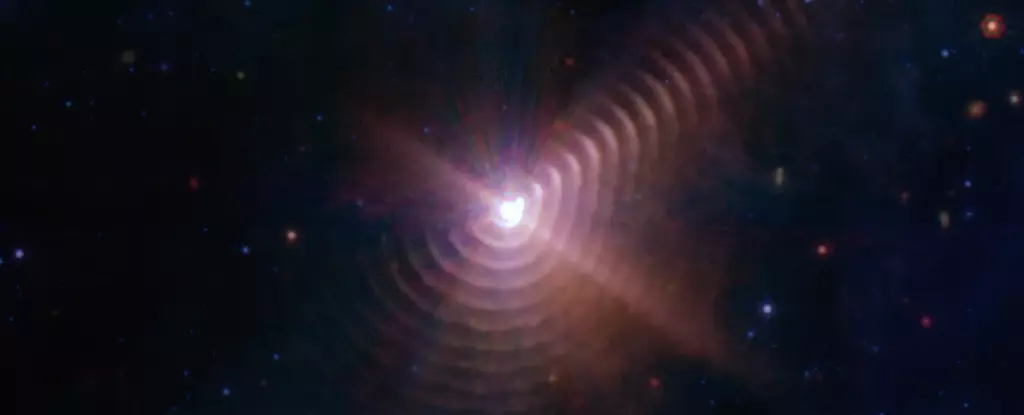Astrophysics often presents a vast panorama of celestial wonders, yet few phenomena mesmerize astronomers quite like the formation of carbon-rich cosmic dust. This elemental presence is crucial for not only the birth of rocky planets, including our own Earth, but also for supporting the intricate tapestry of life. Amid the grandeur of pale celestial bodies are clouds of cosmic dust that often elude our observations, obscuring our understanding of the universe. Thanks to advancements in infrared technology, particularly via the James Webb Space Telescope (JWST), we are beginning to decipher the mysteries surrounding this enigmatic substance.
Understanding the Genesis of Cosmic Dust
Cosmic dust, specifically carbon-rich varieties, originates from stellar processes that eject these elements into the void of space. When astronomers focus their telescopes on intriguing stellar formations, this dust can obscure their observations, complicating their attempts to unravel cosmic secrets. The JWST’s design aims to peer through these obscurations with its advanced infrared capabilities, offering a unique perspective on astrophysical processes. Recent studies have highlighted the Wolf-Rayet binary WR 140, located approximately 5,000 light-years away in the Cygnus constellation. This stellar pair acts as a compelling case study for examining the mechanisms behind the production and movement of cosmic dust.
The 2022 study published in Nature Astronomy outlined the striking dynamics of WR 140, a binary system composed of a Wolf-Rayet star and an OB star that orbit each other with a cycle of 7.93 years. The stars’ stellar winds culminate in explosive collisions that generate concentric rings of carbon-rich dust every time they achieve their closest approach, known as periastron passage. This cyclical dust formation raises essential questions about the dust’s chemical composition and the ways in which it persists over time.
“The chaotic landscape near these stars during periastron is an imposing environment for dust generation,” observed the authors of the paper. Understanding the lifecycle of these dust formations could significantly enhance our knowledge of the interstellar medium, particularly regarding the chemical enrichment necessary for star formation and planet development.
The Role of the JWST in Observational Astronomy
In 2022, data from the JWST corroborated earlier findings, capturing images that revealed the expanding dust rings surrounding WR 140. Lead researcher Emma Lieb noted the significance of these observations, stating, “The telescope confirmed that these dust shells are real, and its data also showed that the dust shells are moving outward at consistent velocities.” Such rapid changes in astronomical objects are a rarity and present a unique insight into cosmic processes typically viewed on a grander timescale.
The contrast between common astronomical phenomena, which usually unfold over millions or billions of years, and the relatively swift changes observed around WR 140 emphasizes the binary system’s unique nature. Co-author Jennifer Hoffman reflected on this distinction, noting, “In this system, the observatory is showing that the dust shells are expanding from one year to the next.”
What makes the carbon-rich dust of WR 140 special lies in its potential role as a factory for building the essential elements that contribute to life as we know it. Through the JWST’s observations, researchers hypothesize that these stellar interactions could have been responsible for pioneering the formation of some of the first dust grains in the early universe.
Moreover, the latest findings indicate that WR 140 could generate tens of thousands of dust shells over extended periods, showcasing how such cosmic systems can continually enrich their environments. The ring-like structures created by the colliding stellar winds display an impressive extent, significantly surpassing those found around other known dust-producing Wolf-Rayet systems by considerable margins, thus underlining their importance within the broader cosmic narrative.
As we delve deeper into the observable universe, it becomes clear that the far-reaching implications of our findings may be profound. The JWST allows astronomers to track these dust formations almost in real time, offering unparalleled insight into not just their production, but also their dynamic evolution over time. Ryan Lau highlighted that, “With these incredible new details, the telescope is also allowing us to study exactly when the stars are forming dust—almost to the day.”
While the future of these dust-producing processes might eventually conclude with the inevitable fate of Wolf-Rayet stars, undergoing supernovae or collapsing into black holes, the ongoing observations of WR 140 will form the cornerstone of our understanding. As we stand on the precipice of astronomical breakthroughs, it is through the tireless exploration of cosmic dust that we will glean more significant insights into the fabric of our universe and its potential for fostering life.


Leave a Reply